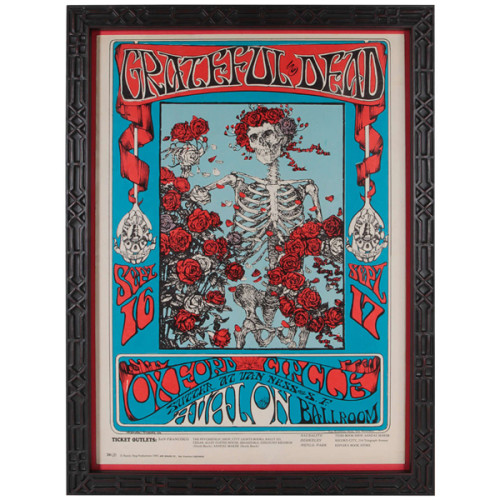Product Description
Stanley Mouse / Alton Kelley, Grateful Dead & Oxford Circle at the Avalon Ballroom September 16 -17, 1966



STANLEY MOUSE USA
ALTON KELLEY USA
Grateful Dead & Oxford Circle at the Avalon Ballroom September 16 -17, 1966
Marked: Mouse Studios 66, 26(3), (c) Family Dog Productions 1966 639 Gough St., San Francisco, Calif. 94102
H: 20″ x W: 14″
Born in Detroit, Stanley Miller became known as “Mouse” after illustrating countless notebooks with his signature rodent sketch. Miller found an outlet for his creativity in pin-striping cars and airbrushing hot rod designs on posters and T-shirts. Mouse migrated to San Francisco in 1964, where he first met the artists associated with Family Dog, the organization producing dance concerts at the Avalon Ballroom. With collaborator Alton Kelley, Mouse experimented broadly with composition, lettering and imagery: Kelley came up with the ideas and Mouse executed the designs. Mouse and Kelley helped to establish the psychedelic style of expression under the name Mouse Studios.
Stanley Mouse / Alton Kelley, Grateful Dead & Oxford Circle at the Avalon Ballroom September 16 -17, 1966
ALYSSA MONKS (b.1977) USA
Push 2006
Oil on canvas
Signed: Alyssa Monks 2006 (on lower back of canvas)
Exhibited: DFN Gallery, New York 2006
Illustrated: American Art Collector, May 2006, p. 155
H: 30” x W: 56”
“Push” is somewhat of a response to the long tradition of bathtub paintings where a nude woman is displayed. However, the figure is me, the painter, so that the subject is also the artist, juxtaposing the objectification of women in that tradition. Also, the figure wears a black negligee and red lipstick, white makeup gently drips down the cheek, closing the door on naturalism.
At the New York Academy of Art, Alyssa Monks studied with Vincent Desiderio, Wade Schuman, Brenda Zlamany, John Jacobsmeyer, Harvey Citron, Deane Keller, Edward Schmidt, Steven Assael, Lisa Bartolozzi, Patrick Connors, Peter Cox, Jon DeMartin, Leonid Lerman, and Hong Nian Zhang. Alyssa’s sensibility of paint and color allows one to be seduced into the illusion of each image. Striving for anatomical and realistic accuracy, it is her intention to elicit a serious confrontation. The work requires attention to detail and a slow and rich execution. It is this artist’s concern to visually relate the contemporary human experience with sensitivity, empathy, and integrity.
